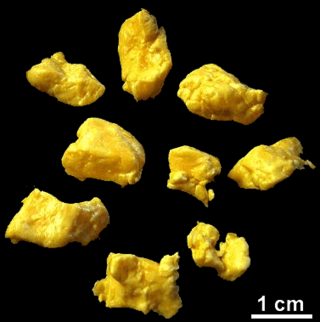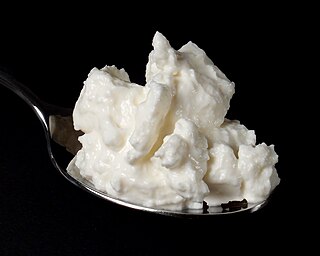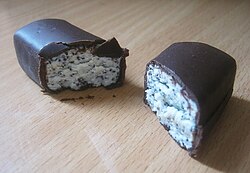
Cottage cheese is a curdled milk product with a mild flavour and a creamy, heterogeneous, soupy texture, made from skimmed milk. An essential step in the manufacturing process distinguishing cottage cheese from other fresh cheeses is the addition of a "dressing" to the curd grains, usually cream, which is mainly responsible for the taste of the product. Cottage cheese is not aged.

Curd is obtained by coagulating milk in a sequential process called curdling. It can be a final dairy product or the first stage in cheesemaking. The coagulation can be caused by adding rennet, a culture, or any edible acidic substance such as lemon juice or vinegar, and then allowing it to coagulate. The increased acidity causes the milk proteins (casein) to tangle into solid masses, or curds. Milk that has been left to sour will also naturally produce curds, and sour milk cheeses are produced this way.

Pierogi or pierogies are filled dumplings, made by wrapping unleavened dough around a filling, and occasionally flavored with a savory or sweet garnish, finally cooked in boiling water.

Pirozhki are foremost, Russian baked or fried yeast-leavened boat-shaped buns with a variety of fillings. Pirozhki are a popular street food and comfort food in Eastern Europe.

Cheese curds are moist pieces of curdled milk, eaten either alone as a snack, or used in prepared dishes. They are most often consumed throughout the northern United States and Canada. Notably, cheese curds are popular in Quebec, as part of the dish poutine, and in Wisconsin and Minnesota where they can be served breaded and deep fried. Curds are sometimes referred to as "squeaky cheese" or fromage en crottes.

Lithuanian cuisine features products suited to the cool and moist northern climate of Lithuania: barley, potatoes, rye, beets, greens, berries, and mushrooms are locally grown, and dairy products are one of its specialties. Various ways of pickling were used to preserve food for winter. Soups are extremely popular, and are widely regarded as the key to good health. Since it shares its climate and agricultural practices with Northern Europe, Lithuanian cuisine has much in common with its Baltic neighbors and, in general, northern countries.
Latvian cuisine typically consists of agricultural products, with meat featuring in most main dishes. Fish is commonly consumed due to Latvia's location on the eastern shore of the Baltic Sea.

Valio Ltd is a Finnish manufacturer of dairy products and one of the largest companies in Finland. Valio's products include cheese, powdered ingredients, butter, yogurt and milk. It is Finland's largest milk processor, producing 85% of the country's milk.

Túró Rudi is the name of a curd snack which has been popular in Hungary since 1968. The bar is composed of a thin chocolate-flavored outer coating and an inner filling of túró (curd). The "Rudi" in the product name comes from the Hungarian "rúd", which translates to rod or bar. Túró Rudi can be made in several different flavours and sizes.

Strauss Group Ltd., formerly known as Strauss-Elite, is an Israeli manufacturer and marketer of consumer foods sold through retail stores. It is among the largest food manufacturers in Israel. Strauss Group focuses on dairy products, coffee, water, snacks, salads, and dips. Its subsidiary Strauss Coffee is a leading coffee company in Eastern Europe and Brazil. Strauss Group is a public company traded in the Tel Aviv Stock Exchange, with the majority of its shares (57%) being owned by the Strauss family.
Traditional Estonian cuisine has substantially been based on meat and potatoes, and on fish in coastal and lakeside areas, but now bears influence from many other cuisines, including a variety of international foods and dishes, with a number of contributions from the traditions of nearby countries. Scandinavian, German, Russian, Latvian, Lithuanian and other influences have played their part. The most typical foods in Estonia have been rye bread, pork, potatoes and dairy products. Estonian eating habits have historically been closely linked to the seasons. In terms of staples, Estonia belongs firmly to the beer, vodka, rye bread and pork "belt" of Europe.

The cuisine of Wisconsin is a type of Midwestern cuisine found throughout the state of Wisconsin in the United States of America. Known as "America's Dairyland", Wisconsin is famous for its cheese as well as other dairy products, such as cheese curds and frozen custard. Other notable foods common to the region include bratwursts, beer and brandy Old Fashioned cocktails, butter burgers, fish fries and fish boils, cranberries, and booyah stew.

Estonia, officially the Republic of Estonia, is a country by the Baltic Sea in Europe. It is bordered to the north by the Gulf of Finland across from Finland, to the west by the sea across from Sweden, to the south by Latvia, and to the east by Lake Peipsi and Russia. The territory of Estonia consists of the mainland, the larger islands of Saaremaa and Hiiumaa, and over 2,300 other islands and islets on the eastern coast of the Baltic Sea, covering a total area of 45,335 square kilometres (17,504 sq mi). Tallinn, the capital city, and Tartu are the two largest urban areas of the country. The Estonian language is the indigenous and official language of Estonia; it is the first language of the majority of its population, the world's second-most spoken Finnic language as well as the third-most spoken Uralic language.

Quark or quarg is a type of fresh dairy product made from milk. The milk is soured, usually by adding lactic acid bacteria cultures, and strained once the desired curdling is achieved. It can be classified as fresh acid-set cheese. Traditional quark can be made without rennet, but in modern dairies small quantities of rennet are typically added. It is soft, white and unaged, and usually has no salt added.

Beer has been brewed in Estonia for over a thousand years. The first written reference to beer in what is now Estonia dates to 1284. In Estonian, beers are often described as hele (pale) or tume (dark).

AS Postimees Grupp, formerly known as AS Postimees and AS Eesti Meedia, is an Estonian media holding company headquartered in Tallinn. The company is currently owned by MM Group, having acquired the half of the company from Norwegian company Schibsted in 2013 and bought the remaining half in 2015. The group is one of the largest media group in the Baltics. Among the Group's activities are creation of print and online media, production of television and radio, e-commerce.

Tourism in Estonia refers to the overall state of the tourism industry in the Baltic nation of Estonia. It is a key part of the country's economy, contributing 7.8% to its GDP, and employing 4.3% of its population. In 2018, tourism and other related services counted for over 10.8 percent of Estonia's exports. Tourism is increasing rapidly in Estonia: the number of tourist arrivals—both domestic and international—has increased from 2.26 million in 2006 to 3.79 million in 2019. Estonia was also ranked the 15th-most safest country to visit in 2017, according to safedestinations.com, scoring 8.94 out of 10 on their list. In a 2018 report published by the OECD, they concluded that most international tourists come from places like Finland, Russia, Latvia, Germany, and Sweden.
















